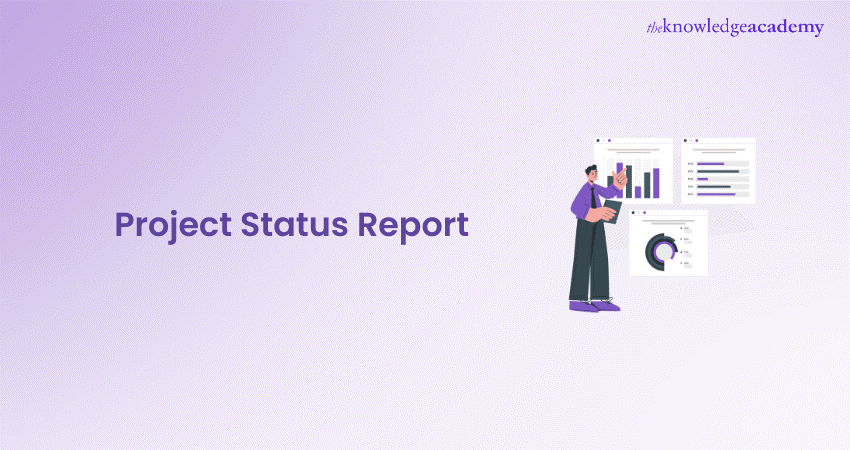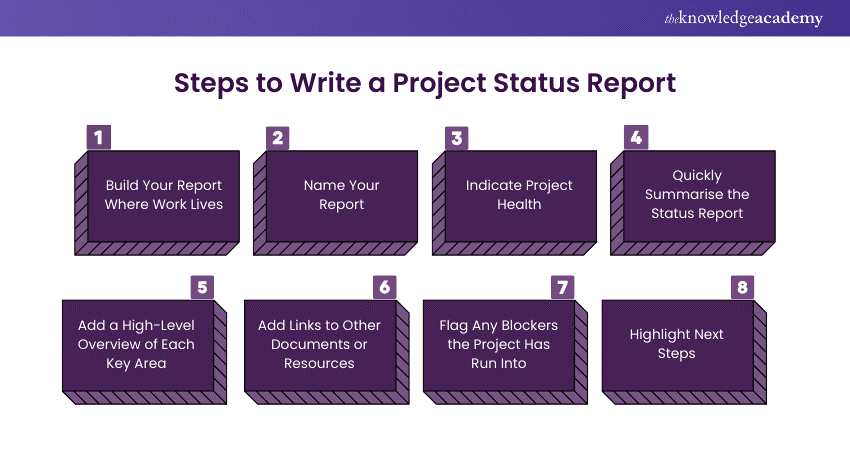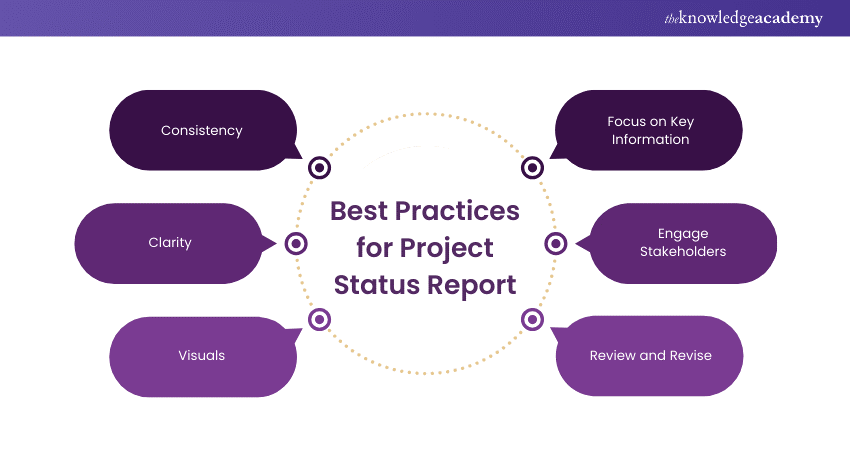We may not have the course you’re looking for. If you enquire or give us a call on +44 1344 203999 and speak to our training experts, we may still be able to help with your training requirements.
We ensure quality, budget-alignment, and timely delivery by our expert instructors.

Project Status Reports are essential documents in Project Management; they represent a quick look at what is happening in a project. They give information on its progress, hurdles encountered thus far, and next steps. This in-depth blog takes a comprehensive look at the Project Status Report, the content to include and recommendations. It further provides the reader with guidelines for mastering them step by step.
Table of Contents
1) What is a Project Status Report?
2) Elements of a Project Status Report
3) Types of Project Status Report
4) Steps to Write a Project Status Report
5) Advantages of Project Status Report
6) Best Practices for Project Status Report
7) Conclusion
What is a Project Status Report?
A Project Status Report is a regular update given to Stakeholders to convey the project's status. It includes crucial details about the project's progress, milestones reached, risks encountered, and overall health. This report is essential for keeping everyone informed, aligned, and equipped to make informed decisions.
Additionally, it fosters transparency and accountability, ensuring that any issues are promptly addressed and managed. Regular status reports also help maintain momentum and stakeholder engagement throughout the project lifecycle.
Elements of a Project Status Report
A well-crafted Project Status Report typically includes some basic elements. Let’s discuss some elements that help you keep track of your project:
1) Project Summary: A summary of the project's objectives, scope, and key deliverables.
2) Project Health: A high-level indicator of the project's status, often represented as red, yellow, or green, to mark troubled, at risk, or on track.
3) Milestones: The report also has a list of milestones achieved followed by the last report and those coming.
4) Tasks Completed: A summary of tasks completed during the reporting period.
5) Upcoming Tasks: An outline of tasks scheduled for the next reporting period.
6) Risks and Issues: Identification of any risks or issues that have arisen, along with their impact and mitigation strategies.
7) Budget Status: An update on the project's financial health, including budget spent and remaining.
8) Next Steps: A brief outline of the immediate steps required to keep the project on track.
Types of Project Status Report
Project Status Report can vary based on the frequency and depth of information required. Here are the common types:
1) Daily Status Report
A daily status report is typically used in fast-paced environments where daily updates are necessary to keep everyone informed. It focuses on tasks completed, tasks in progress, and any immediate issues or blockers.
2) Weekly Status Report
The most common type of report is the weekly status report. It enables both depth and consistency. Specifically, every weekly status report includes activities conducted during the week. For example, key milestones attained, tasks pending the coming week, and challenges faced. Additionally, any possible threat to the project's well-being in cascade management is also covered.
3) Monthly Status Report
Monthly status reports offer a higher-level view of the project, summarising significant accomplishments and progress towards key milestones. It also mentions strategic changes or challenges. These reports are often used for executive briefings.
4) Quarterly Status Report
Quarterly status reports provide a strategic overview, focusing on long-term progress, major achievements, and budget status. It also states significant risks or issues. These reports are typically used for board meetings or stakeholder reviews.
Enhance your Project Management skills with our PM² Foundation Training- Register now!
Steps to Write a Project Status Report
Creating an effective Project Status Report involves several key steps. Here, we have mentioned some of the steps in detail:

1) Build Your Report Where Work Lives
Use Project Management tools to build your report directly within the environment where your project tasks and data reside. This integration ensures real-time updates and accuracy.
2) Name Your Report
Title your report to reflect its purpose and the reporting period. For example, "Project Alpha—Weekly Status Report—01/07/2024." It should indicate report type, along with date and location of report. This makes it easily accessible.
3) Indicate Project Health
Use a simple visual indicator to represent the project's overall health. Red, yellow, and green traffic light systems are commonly used to show troubled, at-risk, and on-track statuses.
4) Quickly Summarise the Status Report
Provide a concise summary of the project's status. Highlight major achievements, significant issues, and overall progress. This summary should give stakeholders a quick snapshot of the project.
5) Add a High-Level Overview of Each Key Area
Break down the report into critical areas such as scope, schedule, budget, and quality. Provide a high-level overview of each area, focusing on status, recent achievements, and upcoming tasks.
6) Add Links to Other Documents or Resources
Include links to relevant documents, resources, or detailed reports. This allows stakeholders to explore specific areas more thoroughly if necessary.
7) Flag Any Blockers the Project Has Run Into
Locate issues that hinder your progress. Also, specify details on its impact, status, and what actions are needed to mitigate it.
8) Highlight Next Steps
Outline the immediate next steps required to maintain momentum. This section should include upcoming tasks, key decisions needed, and any support required from stakeholders.
Advantages of Project Status Report
Project Status Report offers advantages that benefit businesses. Let's discuss the advantages of the Project Status Report in detail here:
1) Transparency: Keeps all stakeholders informed about the project's progress and any issues.
2) Accountability: Clearly defines responsibilities and tasks, ensuring team members are accountable.
3) Decision-Making: Provides the information needed for timely and informed Decision-Making.
4) Risk Management: Identifies risks early, allowing for proactive mitigation.
5) Communication: Improve Effective Communication within the team and with stakeholders, reducing misunderstandings and misalignments.
Master essential techniques with our Project Management Certification Course - Join today!
Best Practices for Project Status Report
To maximise the effectiveness of your Project Status Report, you will require the best practices. Here are some of the best practices:

1) Consistency: Maintain a regular reporting schedule to keep stakeholders consistently informed.
2) Clarity: Use clear and concise language. Avoid jargon and complex terms.
3) Visuals: Incorporate visual elements such as charts, graphs, and traffic light indicators to enhance understanding.
4) Focus on Key Information: Prioritise the most critical information and avoid overwhelming stakeholders with unnecessary details.
5) Engage Stakeholders: Encourage feedback and questions from stakeholders to ensure their concerns and needs are addressed.
6) Review and Revise: Review daily and adjust your reporting process based on the feedback and lessons learned.
Conclusion
We hope you understand what a Project Status Report is. Providing regular updates on the project's progress, health, and risks ensures that all stakeholders are aligned and able to make informed decisions. Implementing this blog's best practices and steps will help you create a complete, clear, and impactful Project Status Report.
Gain practical Project Management insights from our Project Management For Non-Project Managers Course - Join today!
Frequently Asked Questions
What Should you do if There are Delays or Setbacks in the Project?

In your Project Status Report, it is essential to promptly communicate any delays or setbacks that may arise. Clarify why the delays are occurring, describe how they affect the project, and outline the measures implemented to resolve them. Offering a schedule and any extra assistance required from those involved can also be beneficial.
Should Project Status Report Include Financial Information?

Yes, the Project Status Report should include financial information. This typically consists of the budget spent to date, any variances from the planned budget, and forecasts for future spending. Including financial information helps stakeholders understand the project's economic health and make informed decisions.
How Can Feedback from Project Status Report be Used to Improve Future Projects?

Feedback from Project Status Report can be invaluable for continuous improvement. Analyse the feedback to identify common issues, areas for improvement, and successful strategies. You can use this information to refine your Project Management processes, improve communication.
What are the Other Resources and Offers Provided by The Knowledge Academy?

The Knowledge Academy takes global learning to new heights, offering over 3,000 online courses across 490+ locations in 190+ countries. This expansive reach ensures accessibility and convenience for learners worldwide.
Alongside our diverse Online Course Catalogue, encompassing 19 major categories, we go the extra mile by providing a plethora of free educational Online Resources like News updates, Blogs, videos, webinars, and interview questions. Tailoring learning experiences further, professionals can maximise value with customisable Course Bundles of TKA.
What is The Knowledge Pass, and How Does it Work?

The Knowledge Academy’s Knowledge Pass, a prepaid voucher, adds another layer of flexibility, allowing course bookings over a 12-month period. Join us on a journey where education knows no bounds.
What are the Related Courses and Blogs Provided by The Knowledge Academy?

The Knowledge Academy offers various PM² Project Management Training, including PM² Foundation Training, Project Management Black Belt, and Project Management Green Belt. These courses cater to different skill levels and provide comprehensive insights into 12 Project Management Methodologies.
Our Project Management Blogs cover a range of topics related to Project Management, offering valuable resources, best practices, and industry insights. Whether you are a beginner or looking to advance your Project Management skills, The Knowledge Academy's diverse courses and informative blogs have got you covered.
Upcoming Project Management Resources Batches & Dates
Date
 PM² Foundation Training
PM² Foundation Training
Thu 3rd Apr 2025
Thu 8th May 2025
Thu 10th Jul 2025
Thu 18th Sep 2025
Thu 6th Nov 2025






 Top Rated Course
Top Rated Course



 If you wish to make any changes to your course, please
If you wish to make any changes to your course, please


